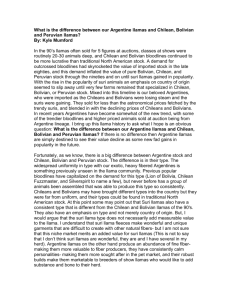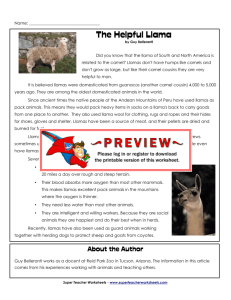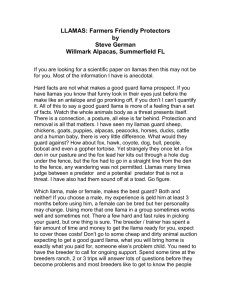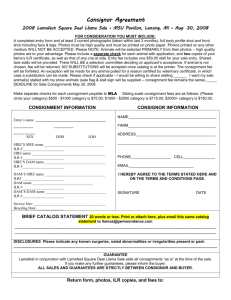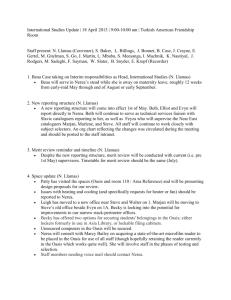Comparing Manager and Visitor Perceptions of Llama Use in Wilderness Alan E. Watson
advertisement
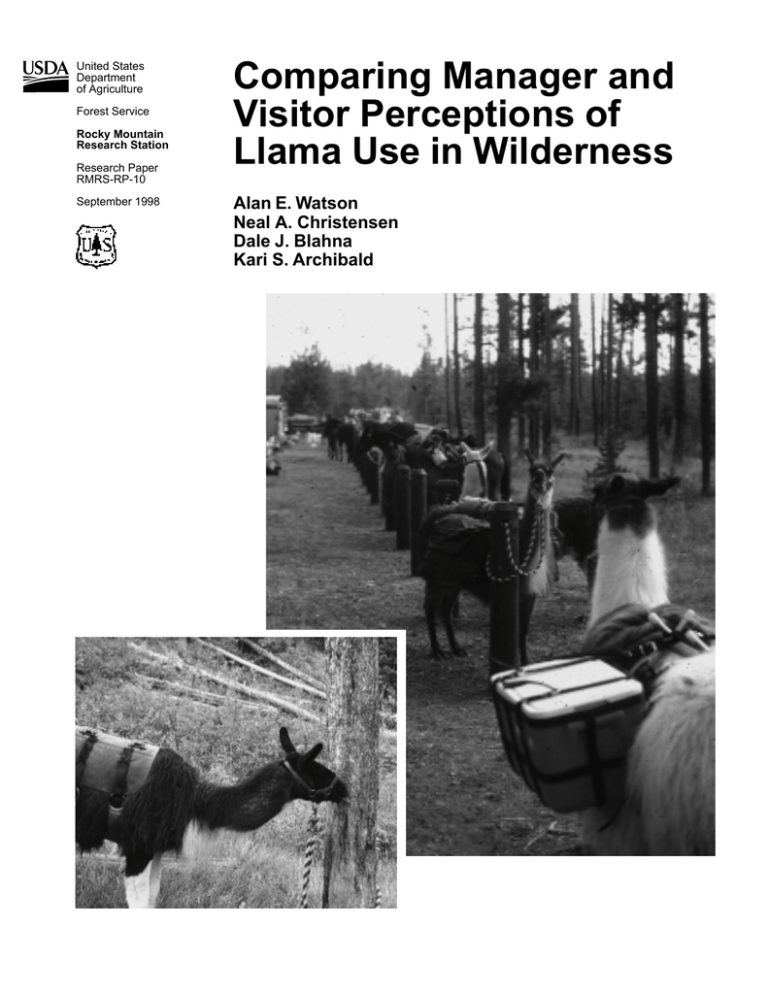
United States Department of Agriculture Forest Service Rocky Mountain Research Station Research Paper RMRS-RP-10 September 1998 Comparing Manager and Visitor Perceptions of Llama Use in Wilderness Alan E. Watson Neal A. Christensen Dale J. Blahna Kari S. Archibald The Authors Research Summary Alan E. Watson is a Research Social Scientist for the Rocky Mountain Research Station’s Aldo Leopold Wilderness Research Institute, Missoula, MT. He attended the School of Forestry and Wildlife Resources, Virginia Polytechnic Institute and State University, Blacksburg, receiving B.S. and M.S. degrees, and in 1983, a Ph.D. degree. His research interests are primarily in wilderness experience quality, including influences of conflict, solitude, and visitor impacts. Llama use in wilderness and backcountry in the United States is increasing. While the greatest concerns about this increase in use are unexpected impacts to native flora, impacts to native fauna, and conflicts with other user types, there is also concern about how prepared managers are to meet this increasing recreation demand. Questions that assess knowledge and attitudes about llamas, which have recently been posed to hikers and horseback riders in the Yellowstone region of Wyoming and to a sample of commercial llama customers, were also posed to a nationwide sample of Forest Service wilderness managers. Quite often, llama users and horseback riders expressed opinions representing opposite ends of a spectrum, with managers typically somewhere in the middle, but closer to horse rider attitudes. In some instances, llama user perceptions were extremely different, with all other groups indicating some level of agreement. In light of managers’ expectations that all packstock use will continue to increase over the next 5 years, this assessment of differences in attitudes will help in understanding current positions regarding impacts of llama use in wilderness. Neal A. Christensen is a Social Science Analyst for the Rocky Mountain Research Station’s Aldo Leopold Wilderness Research Institute, Missoula, MT. He received a B.S. degree in forest recreation from the University of Montana, and in 1989, an M.S. degree in recreation from Texas A&M University. His research experiences include assessing the condition of social and economic systems, and the influences on those systems resulting from recreation and tourism development decisions. Dale J. Blahna is an Associate Professor in the Forest Resources Department and Director of the Institute of Outdoor Recreation and Tourism at Utah State University. He has a B.A. degree in conservation from the University of Wisconsin-Milwaukee, an M.S. degree in outdoor recreation and environmental interpretation from the University of Wisconsin-Stevens Point, and a Ph.D. degree in recreation and the human dimensions of natural resources management. His current research topics include visitor attitudes and behavior, social equity and effectiveness of natural resource policy and decisionmaking, and community benefits of public lands. Kari S. Archibald is the Recreation Education Department Chair at Ricks College in Rexburg, ID. She has a B.S. degree in recreation education from Brigham Young University, an M.Ag. degree in recreation and resources development from Texas A&M University, and is currently working on a Ph.D. degree in recreation resources management at Utah State University. Her teaching and research interests include outdoor leadership, backcountry recreation impacts and visitor behavior, and outdoor learning and recreation opportunities for women and minorities. Her dissertation is on visitor motives for participating in backcountry llama packing. Contents Page Introduction ................................................................. 1 Impacts on Visitor Experiences ............................... 1 Impacts on Biophysical Conditions .......................... 1 Impacts on Native Fauna ......................................... 2 Purpose ....................................................................... 2 Methods ...................................................................... 3 Results ........................................................................ 3 Manager Experiences with Llamas .......................... 3 Decisionmaker Attitudes Toward Llamas ................ 4 Direct Resource Manager Attitudes Toward Llamas ..................................................... 6 Conclusions ................................................................. 6 References .................................................................. 7 Rocky Mountain Research Station 324 25th Street Ogden, UT 84401 Comparing Manager and Visitor Perceptions of Llama Use in Wilderness Alan E. Watson Neal A. Christensen Dale J. Blahna Kari S. Archibald Introduction ____________________ Llamas are careful, sure-footed animals that can carry a high ratio of weight to their body weight; they are easy to manage for most people, learn quickly, and are generally willing trail partners. They are calm, quiet and patient…. They can utilize low quality forage, and derive a certain amount of water from the vegetation…. Although they do not generally carry adults, they can pack smaller children, when trained, and have been known to carry an injured adult in an emergency. (Lilienthal 1992, item # 6) The use of llamas as recreational packstock has increased significantly in recent decades (Brunson 1995). This relatively new mode of wilderness travel has stimulated a significant amount of discussion about the appropriateness of seemingly nontraditional uses of wilderness. Brunson (1995) suggests that because llamas are not indigenous to the United States, the tendency to ban them could increase. While potential negative impacts such as disease transmission to native wildlife are not easily confirmed, concern about “exotic” species is increasing in wilderness management as well as in conservation biology circles, and some people believe it is wisest to presume guilt until proven otherwise. Llamas are believed to account for only about 5 percent of all packstock use (McClaran and Cole 1993), and rules against llama use can be enacted by land management agencies with relatively low political cost. Greater knowledge is needed about llamas and how they may affect the wilderness environment. There are three major concerns about potential impacts of llamas: • Visitor experiences • Biophysical conditions • Native fauna Impacts on Visitor Experiences A systematic sample of overnight wilderness users at the John Muir and Sequoia-Kings Canyon National Park Wildernesses in California in 1990 (Watson and USDA Forest Service Res. Pap. RMRS-RP-10. 1998 others 1993) found only 1 percent in the Muir and 6 percent in Sequoia-Kings Canyon hiking with llamas. In the John Muir Wilderness, however, 24 percent of hikers and 34 percent of horse users reported having met llama groups during a recent trip. Similarly, for the Sequoia-Kings Canyon Wilderness, 21 percent of hikers and 29 percent of horse users encountered llamas inside the wilderness. For those who met llamas, the majority reported enjoying or at least not minding the encounter (82 percent of hikers in the Muir, 56 percent in Sequoia-Kings Canyon; 91 percent of horse users in the Muir and 72 percent in SequoiaKings Canyon). Only in Sequoia-Kings Canyon did a sizable number of hikers (44 percent) report disliking the encounters they had with llamas. In a 1993 survey of 337 backcountry visitors to Yellowstone National Park and the Jedediah Smith Wilderness (just south of the Park in Wyoming; see fig. 1), Blahna and others (1995) found that only about 3 percent of the sample traveled with llamas. However, 29 percent of the Yellowstone visitors and 32 percent of Jedediah Smith visitors reported encountering llama groups on their hike or horseback ride, which was similar to findings in the Sierras. About half of the respondents reported that they had encountered llamas in the backcountry at some point in the past 5 years. At these locations about 20 percent of hikers and 28 percent of horse riders disliked the encounters they had with llamas. Impacts on Biophysical Conditions Research by DeLuca and others (1998) compared soil erosion effects related to llamas, horses, and hikers on an existing trail in western Montana. They found that the horse traffic consistently made more sediment available for erosion from trails than llamas, hikers, or no traffic when analyzed on wet and dry trail plots at high and low traffic intensity. Llama traffic caused a significant increase in sediment yield compared to the control, but caused erosion yields not significantly different than hiker traffic. 1 Impacts on Native Fauna Figure 1—Manager responses were compared to those of visitors at Jedediah Smith Wilderness and Yellowstone National Park. Impacts on trails are not the only concerns about the resource. Blahna and others (1995) reported that wilderness visitors “mildly agreed” with the belief that llamas cause little impact to vegetation due to their eating habits (average of 3.4 on a scale of 1 = strongly disagree to 5 = strongly agree, with 3 representing neutral). However, about three-fourths of the respondents indicated some uncertainty about the extent of vegetative impacts by llamas by either giving a neutral score or indicating they “did not know.” Llamas browse and graze when the opportunity is given them, eating all types of forbs, grasses, sedges, shrubs, and small trees. They do not, however, strip an area clean of all vegetation. While llamas are generally easy on vegetation, when they are stationary for the night or during a layover of a day or more, there will be effects. Having only a lower set of front teeth, they have been observed using these teeth to strip bark from standing trees if tied to that tree long enough. Llamas do not paw while standing like horses commonly do, but they will sometimes scratch out a bed for lying or rolling. The length of time a llama is tied in one spot and the location selected for staking are controllable by the visitors and can be used to reduce impacts. 2 Generally, wilderness visitors do not perceive that llamas pose a threat of escaping and competing with wildlife for space and food, though a substantially larger proportion do believe that llamas threaten introduction of diseases that can harm the native wildlife (Blahna and others 1995). However, in 1994 the potential threat relating to llamas transmitting Johne’s disease to bighorn sheep at Arches and Canyonlands National Parks in Utah was recognized. Johne’s disease is a condition affecting cattle and sheep in Europe, North America, and Asia, with some reports of suspected occurrence in goats, deer, buffalo, and gnu. Infected animals experience chronic diarrhea, loss of weight, and a substantial drop in milk production. The disease is spread mainly in the droppings of diseased animals. In 1954, this infection was observed in a llama at a zoological park in Edinburgh (Appleby and Head 1954) and then in the United States in 1994 by veterinarians at Colorado State University (Belknap and others 1994). Early in this century, bighorn sheep on Mt. Evans in Colorado were believed to have received Johne’s disease from domestic sheep. In 1994, the Superintendent of Arches and Canyonlands National Parks issued an order banning the use of llamas from the parks for a combination of the above stated reasons. Response from both users and veterinarians was mixed. While the ban remains in effect, the extent of this threat is still undetermined. Purpose _______________________ While some knowledge has been accumulated about llama impacts on visitors and the resource, very little is known about how wilderness managers perceive the seriousness of llama impacts or future challenges in meeting demands of llama users. This report compares the answers received from wilderness users in the study by Blahna and others (1995), which was cosponsored by the Aldo Leopold Wilderness Research Institute as part of a short-term emphasis on developing knowledge about llamas, to answers on the same questions by Forest Service wilderness managers. Additionally, Blahna and Archibald (1997) recently published results of a related study of clients of llama outfitters, allowing comparison of attitudes held by managers, hikers, horse users, and llama users. The purpose of the study is to develop knowledge about managers’ perceptions of trends in llama use, how seriously they consider some important types of potential impacts, and their general perceptions of appropriateness of llamas in wilderness. With greater understanding of how managers’ perceptions compare to USDA Forest Service Res. Pap. RMRS-RP-10. 1998 visitors’, working toward common ground in management should become easier. Methods _______________________ A sample of Forest Service wilderness managers from across the country was selected. Based on answers to a 1990 survey by McClaran and Cole (1993), we developed a sample that contained 100 percent of those units reporting more than 10 llama trips in the past 5 years (n = 103, with only 14 units reporting 50 or more trips), 75 percent of those reporting 1 to 10 trips in the past 5 years (n = 85), and 50 percent of those reporting no llama use between 1984 and 1989 (n = 49). In addition, we took a 25 percent sample of those units that did not answer the earlier survey or did not answer this question (n = 24). With telephone followups, the response was 92 percent (n = 241) of all managers who were sent the survey. The manager survey had two parts. The first part was to be completed by the person most involved with making decisions about management of the wilderness. The most common job title of the person completing this part of the survey was District Ranger (50 percent). Other position titles listed included Resource Assistant (8 percent), Recreation Officer (6 percent), and a mix of Wilderness Coordinators, Recreation Staff, Recreation Planners, Wilderness Rangers, and others (36 percent). These respondents had been in their current positions from 1 to 27 years, with an average of 6 years. This part of the survey consisted of questions about perceived trends in llama use, whether they have encountered llamas in wilderness while performing the duties of their positions, attitudes toward uniform application of regulations to all packstock, perceptions of seriousness of problems with conflict between llama users and other parties, and the amount of training they have had on managing llamas. They were asked the same questions that the sample of visitors to the Yellowstone region wildernesses and the commercially outfitted llama users had been asked about attitudes toward llamas in wilderness. The second part of the survey was to be completed by the person most knowledgeable about current use of the area by llama groups and who has the best knowledge about current conditions in the wilderness. Of the respondents to this section, 21 percent were Wilderness Rangers, 13 percent were Wilderness Coordinators, and the rest were a mixture of Forestry Technicians, Resource Assistants, Recreation personnel, Recreation Foresters, Wilderness Technicians, Resource Assistants, and others (56 percent). Similar to the respondents to Part I, they ranged from 1 to 22 years in their current positions, with an average of 6 years. These managers were asked for their perceptions of seriousness for several conflict issues USDA Forest Service Res. Pap. RMRS-RP-10. 1998 (including encounters with llamas), a series of questions that were the same as posed to visitors about how serious several resource impact problems are (including those from llama use), the proportion of stock use in the areas they manage that is attributed to llamas, expectations about trends in llama use, and levels of training on llama issues. The data for comparison to visitor attitudes was reported by Blahna and others (1995) and by Blahna and Archibald (1997). Trailhead contact to obtain addresses for mail surveys was used to collect information from visitors at two different areas in the Yellowstone region in 1993 and 1994, both with some known llama use occurring. The Jedediah Smith Wilderness is part of the Targhee National Forest on the western range of the Teton mountains in Wyoming, and is used primarily by local rural residents, with about half on horseback. Visitors were contacted at the North Leigh Creek and Coyote Meadows trailheads as they finished their trips. The other location for visitor surveys was at the Bechler River Ranger Station, a heavily used recreation access in southwestern Yellowstone National Park, where less than one-fifth of the users were on horseback. With a 74 percent response rate to the mail survey, this sample included 209 hikers and 113 horseback riders. Additionally, Blahna and Archibald (1997) reported on data from a separate nonrandom survey of llama users, taken from the clients of 14 commercial llama packers in Wyoming, Idaho, Montana, Oregon, and Washington. This sample of 326 represents a 92 percent response rate to a mail-back questionnaire. Results ________________________ After a brief description of answers to questions that the two different types of managers were asked about training they have received, current llama use, and anticipated trends, manager responses are compared to user responses on the range of attitudes and perceptions investigated by Blahna and others (1995) and by Blahna and Archibald (1997). Manager Experiences with Llamas The decisionmakers reported very little formal training about llamas (81 percent had none), with the more direct resource managers having only slightly more formal training (24 percent had “less than 1 week” training; the rest had none). Just slightly over half (52 and 55 percent, respectively) of both groups had no informal training about llamas as well. Slightly over one-fourth of the decisionmakers had encountered llamas in the wilderness in which they now work. To put that figure into perspective, 82 percent had encountered horses. Over the past year, just for those 3 who had encountered llamas in their wilderness, the average was 1.2 llama groups encountered. The maximum was 10 groups. For horses, the average was more than 12 groups for the past year, with the maximum number of groups encountered estimated to be 200. The decisionmakers reported an average of about 10 trips of a few hours’ duration into the wilderness each year, 10 trips lasting a full day, four trips lasting one or two nights, and three trips lasting more than two nights. As expected, the more direct resource manager reported more trips lasting for a few hours (averaging nearly 15 per year), a full day (17 per year), a night or two (six per year), and more than two nights (five per year). The direct resource managers reported substantial numbers of llama trips during the past 5 years in the wildernesses they managed. While 21 percent reported no visits (about the targeted proportion of this sample based on expectations from the earlier manager study by McClaran and Cole, 1993), 37 percent reported 1 to 10 trips, 22 percent reported 11 to 50 trips, and 12 percent reported more than 50 trips. These managers reported an average of 92 percent of their packstock use as horse use and just over 5 percent as llama use, although the proportion of packstock use that was llama use ranged as high as 30 percent at four destinations. Based on their past experience, 37 percent of these managers felt llama use would stay the same, only 1 percent thought it would decrease (hard to do at the 21 percent of the places with no llama use currently allowed), and 62 percent felt it was likely to increase over the next 5 years. For horse use, the expectations were similar, with 39 percent expecting it to stay the same, 3 percent expecting it to decrease, and 58 percent expecting it to increase. Decisionmaker Attitudes Toward Llamas For this analysis the sample of managers was weighted to represent the population of Forest Service wilderness managers. Weighting was based on the earlier described sampling scheme, bringing attitudes of managers with low or no llama use to bear a more representative amount on the comparisons with visitors. Unfortunately, we do not have the ability to project whether any of the areas with no llama use are likely to have this type of use in the future. Table 1 provides statistical analysis results from comparison of responses from the four groups (3 visitor, 1 manager). These analyses consist of comparisons of mean values on a scale of 1 = strongly disagree to 5 = strongly agree. From this table one can determine differences in the strength of agreement with the statements provided as an indication of differences in attitudes toward llamas. There are many items with statistical differences, with llama users showing 4 significantly different attitudes from the other groups, and sometimes the horse users and llama users demonstrating diametrically opposing opinions, with managers somewhere in the middle, but different from horse or llama users. For instance, 60 percent of llama users did not think use regulations should be the same for llamas as they are for horses and mules. At the opposite end of opinion, 77 percent of horse users thought they should be treated the same; 60 percent of managers agreed. Only 36 percent of llama users believed that safety problems will occur when llamas meet horses or mules on the trail, compared to about 70 percent of both managers and horse users who believed a safety problem will occur. For some of the issues, all of the groups expressed significantly different opinions, for example: Horses and mules are more appropriate in wilderness than llamas. The mean scores show that each of the four groups differed in their opinions, with horse users agreeing with this statement most, managers second most, hikers tending toward the disagreement side, and llama users most strongly disagreeing. Looking more closely at the responses of each groups, 95 percent of llama users disagreed with this statement, 70 percent of hikers disagreed, 56 percent of managers disagreed, and 30 percent of horse users disagreed, following much the same lines as the mean scores, but further clarifying the very different opinions held by these four groups. There were some cases where llama users’ opinions were different from all three of the other groups, such as their perceptions of how interesting it is to meet groups with llamas in the wilderness and whether llama users are experienced wilderness users. Llama users felt much stronger that llama groups are interesting to meet and that llama packers are experienced visitors, though all groups tended to agree with these statements. Similarly, llama users expressed significantly less agreement on the potential for llamas to escape and reproduce in the wild; whether llamas are out of place in the wilderness; whether they pose a greater threat of introduction of exotic plant species than horses, mules, or hikers due to seed being attached to their wool; and stronger agreement that llamas cause little impact to vegetation due to their eating habits. Most managers were neutral or tended to disagree with statements indicating that llamas pose a threat to vegetation or native plants and wildlife. On questions related to visitor experiences, managers tended to agree that llamas posed a safety problem for horse and mule packers and that use regulations should be the same for llamas as they are for other packstock. They tended to disagree that llamas were less appropriate in wilderness than horses and mules. In general, most means were in the middle of the scale, and USDA Forest Service Res. Pap. RMRS-RP-10. 1998 Table 1—Comparisons between primary decisionmaker managers’ and wilderness visitors’ attitudes toward llamas. Comparison item Manager Hiker Type of visitor Horse user Llama clients a - - - - - - - - - - - - - - - - - - (mean ) - - - - - - - - - - - - - - - - - - - Tamhane testb Regulations should be the same for llamas as for horses and mules. 3.6a 3.9ab 4.1b 2.6c Horses and mules are more appropriate in the wilderness than llamas. 2.4a 2.0b 3.3c 1.3d Meeting a group of hikers with pack llamas makes a trip more interesting. 3.3a 3.4a 3.1a 4.3b Safety problems will occur when llamas meet horses or mules on the trail. 3.7a 3.2b 3.7a 2.8b In general, llama packers are experienced visitors. 3.3a 3.3a 3.2a 4.2b Llamas escaping might reproduce in the wild, introducing an exotic species to compete with native wildlife. 1.9a 2.3a 2.0a 1.4b Seeing llamas in the wilderness seems out of place. 2.3a 2.8a 3.0a 1.6b Llamas pose the threat of introduction of disease to native wildlife. 2.3a 2.9b 2.7ab 1.4c The limit for number of llamas per group should be the same as the limit for the number of horses or mules per group in wilderness. 3.9a 3.7a 4.1a 2.6b Llamas pose more of a threat of introduction of exotic plant species than horses, mules, or hikers, due to seeds being attached to their wool. 2.5a 2.6a 2.9a 1.5b Safety problems are more likely to occur when llamas meet mules on the trail than when llamas meet horses on the trail. 2.5a 2.7a 2.8a 2.0b When llamas meet horses or mules on the trail, llamas should be led off the trail, giving horses or mules the right of way. 3.6a 3.0a 3.8a 3.9a Hikers don’t mind camping in sites previously occupied by horses or mules. 1.9a 1.9a 3.0b 1.8a Hikers don’t mind camping in sites previously occupied by llama packing groups. 2.9a 2.5b 2.9a 4.1c Llamas cause little impact to vegetation due to their eating habits. 3.4a 3.4a 3.2a 4.1b Least significant difference test c a Means reported represent average across all nonmissing values on a scale from 1 = strongly disagree to 5 = strongly agree. Tamhane test is a conservative, pair-wise comparison based on the t-test (for unequal variances). Letters (a, b, c, d) associated with means indicate significant differences at p <0.05. c Least significant difference test. Letters (a, b, c) associated with means indicate significant differences at p <0.05. b USDA Forest Service Res. Pap. RMRS-RP-10. 1998 5 there was no strong consensus supporting or disapproving of the use of llamas in wilderness. Direct Resource Manager Attitudes Toward Llamas Another set of questions asked of the direct resource managers were directly comparable to questions from Blahna and others (1995) and Blahna and Archibald (1997). All subjects were asked about perceptions of problems related to encountering several types of groups in wilderness and some of the physical impacts attributable to these other groups (table 2). In general, managers felt there was more conflict than visitors reported. While most managers and hikers felt that there is very little problem with hikers meeting llamas on the trail, many more hikers (52 percent) felt there is no problem associated with encountering horses than managers thought (12 percent). Managers also assumed that horses meeting llamas on the trail was a bigger problem than either horse users or llama users reported. Horse users perceived problems associated with horse manure on trails or in campsites as much less serious than was perceived by any of the other groups, with 92 percent of horse users convinced it caused no problem at all (compared to only 9 percent of the managers with the same opinion). Similarly, horse users rated the problem of trails impacted by the feet of horses or mules as much less severe than was rated by the other groups. Here again, most horse users (92 percent) felt there was no problem at all associated with trail impacts from horses and mules, while only about 8 percent of managers agreed. Similarly, managers tended to feel there were more problems from llama impacts than were felt by the visitor groups. Most hikers, horse users, and llama users felt that llama manure caused no problem at all (80 to 90 percent), although only about 62 percent of managers felt that way. Similarly, 88 to 95 percent of the three user groups felt that trails impacted by llamas were no problem, and 69 percent of managers felt they were not a problem. Conclusions ____________________ It is noteworthy that so many of the managers are expecting a continued increase of all packstock use over the next 5 years. With this anticipated increase, monitoring conflict issues and resource impacts seem of increasing importance. We reaffirm the perception that llamas account for about 5 percent of all packstock use, although it is as high as 30 percent in a few places. The differences in attitudes toward llama use, between llama users and managers particularly, suggest the need for continued dialogue and education. Noteworthy is the tendency of both packstock user groups to perceive very few problems associated with their own type of use, while other user groups and managers tend to perceive greater problems with the same type of use. Greater awareness of safety concerns among horse users and managers seems of particular importance. Blahna and Archibald (1997) have provided some Table 2—Comparisons between direct resource managers’ and wilderness visitors’ perceptions of llamas in wilderness. Comparison item Manager Hiker Type of visitor Horse user Llama clients a - - - - - - - - - - - - - - - - - - (mean ) - - - - - - - - - - - - - - - - - - - T-testb Hikers encountering llamas on the trail. 1.3a 1.2a — — Hikers encountering horses or mules on the trail. 2.5a 2.0b — — Horses or mules encountering llamas on the trail. 2.1a — 1.5b 1.9b Horse manure on trails or in campsites. 2.8a 2.6ac 1.1b 2.3c Trails impacted by feet of llamas. 1.4a 1.2a 1.2ab 1.1b Trails impacted by feet of horses or mules. 3.0a 2.4b 1.1c 2.2b Llama manure on trails or in campsites. 1.6a 1.2b 1.1b 1.3b Tamhane test c a Means reported represent average across all nonmissing values on a scale from 1 = no problem to 5 = big problem. T-test: Letters (a, b) associated with means indicate significant differences at p <0.05. Tamhane test is a conservative, pair-wise comparison based on the t-test (for unequal variances). Letters (a, b, c) associated with means indicate significant differences at p <0.05. b c 6 USDA Forest Service Res. Pap. RMRS-RP-10. 1998 recommendations for exposing horses to llamas before going on wilderness trips to reduce safety hazards. A large percentage (sometimes 50 percent or more) of wilderness users were unable to respond to many of the questions about llamas and llama impacts (Blahna and others 1995). This suggests a general lack of knowledge about this emerging form of wilderness use and a prime subject for education efforts before opinions become rooted. To further alleviate potential conflicts as all types of packstock use grows, it may be beneficial to increase education efforts with all stock users about their influence on others’ experiences, and methods they might use to reduce impacts. Managers also would benefit from becoming more informed about llama use. Through long-term exposure to horse packstock, managers are very aware of issues associated with that type of backcountry use. However, their perceptions of issues associated with llamas are not congruent with views held by backcountry users— particularly llama packers. Training focused on recently acquired knowledge about llama impacts and on visitor response to llamas may help managers develop more formal management plans. Blahna and Archibald (1997) acknowledge that the sample of commercial llama packing customers used in these comparisons is probably not representative of all llama users because those who use their personally owned llamas were not included in the sampling frame used here. Attitudes of llama owners, who may be more actively involved in llama access issues and more knowledgeable about llama behavior, might hold even USDA Forest Service Res. Pap. RMRS-RP-10. 1998 more disparate views from those held by managers and other stockholders. Therefore, these findings may represent a conservative view of llama interests. References _____________________ Appleby, E. C.; Head, K. W. 1954. A case of suspected Johne’s disease in a llama. Journal of Comparative Pathology. 64: 52-53. Belknap, E. B.; Getzy, D. M.; Johnson, LaRue W.; Ellis, Robert P.; Thompson, Gayle L.; Shulaw, W. P. 1994. Mycobacterium paratuberculosis infection in two llamas. Journal of American Veterinary Medicine Association. 204(11): 1805-1808. Blahna, D. J.; Archibald, K. S. 1997. Backcountry llama packing: what do other wilderness visitors think? Yellowstone Science. Summer: 9-12. Blahna, Dale J.; Smith, Kari S.; Anderson, Janet A. 1995. Backcountry llama packing: visitor perceptions of acceptability and conflict. Leisure Sciences. 17: 185-204. Brunson, Mark W. 1995. The changing role of wilderness in ecosystem management. International Journal of Wilderness. 1(1): 12-16. DeLuca, T. H.; Patterson, W. A., IV; Freimund, W. A.; Cole, D. N. 1998. Influence of llamas, horses, and hikers on soil erosion from established recreation trails in western Montana, USA. Environmental Management. 22(2): 255-262. Lilienthal, Christina, comp. 1992. Llama use policy background data: questions and answers related to llamas. Unpublished discussion paper on file at: U.S. Department of Agriculture, Forest Service, Pacific Northwest Region, Portland, OR. 14 p. McClaran, Mitchel P.; Cole, David N. 1993. Packstock in wilderness: use, impacts, monitoring, and management. Gen. Tech. Rep. INT-301. Ogden, UT: U.S. Department of Agriculture, Forest Service, Intermountain Research Station. 33 p. Watson, Alan E.; Niccolucci, Michael J.; Williams, Daniel R. 1993. Hikers and recreational stock users: predicting and managing recreation conflicts in three wildernesses. Res. Pap. INT-468. Ogden, UT: U.S. Department of Agriculture, Forest Service, Intermountain Research Station. 35 p. 7 8 USDA Forest Service Res. Pap. RMRS-RP-10. 1998 Watson, Alan E.; Christensen, Neal A.; Blahna, Dale J.; Archibald, Kari S. 1998. Comparing manager and visitor perceptions of llama use in wilderness. Res. Pap. RMRS-RP-10. Ogden, UT: U.S. Department of Agriculture, Forest Service, Rocky Mountain Research Station. 7 p. Llama use in wilderness is projected to increase over the next 5 years. While the greatest concerns about this increase in use are unexpected impacts to native flora, impacts to native fauna, and conflicts with other user types, there is also concern about how prepared managers are to deal with this increasing recreation demand. This research compares manager attitudes and knowledge to those of hikers, horseback riders, and commercial llama customers in the Intermountain West. With managers’ expectations that all packstock use will continue to increase in the near future, this assessment of differences in attitudes will help in understanding current positions regarding impacts of llama use in wilderness. Keywords: recreation, packstock, attitudes, management, horses You may order additional copies of this publication by sending your mailing information in label form through one of the following media. Please specify the publication title and Research Paper number. Ogden Service Center Telephone FAX E-mail Web site Mailing Address Fort Collins Service Center (801) 625-5437 (970) 498-1719 (801) 625-5129, Attn: Publications (970) 498-1660 pubs/rmrs_ogden@fs.fed.us rschneider/rmrs@fs.fed.us http://www.xmission.com/~rmrs http://www.xmission.com/~rmrs Publications Distribution Rocky Mountain Research Station 324 25th Street Ogden, UT 84401 Publications Distribution Rocky Mountain Research Station 3825 E. Mulberry Street Fort Collins, CO 80524 Federal Recycling Program Printed on Recycled Paper RMRS ROCKY MOUNTAIN RESEARCH STATION The Rocky Mountain Research Station develops scientific information and technology to improve management, protection, and use of the forests and rangelands. Research is designed to meet the needs of National Forest managers, Federal and State agencies, public and private organizations, academic institutions, industry, and individuals. Studies accelerate solutions to problems involving ecosystems, range, forests, water, recreation, fire, resource inventory, land reclamation, community sustainability, forest engineering technology, multiple use economics, wildlife and fish habitat, and forest insects and diseases. Studies are conducted cooperatively, and applications may be found worldwide. Research Locations Flagstaff, Arizona Fort Collins, Colorado* Boise, Idaho Moscow, Idaho Bozeman, Montana Missoula, Montana Lincoln, Nebraska Reno, Nevada Albuquerque, New Mexico Rapid City, South Dakota Logan, Utah Ogden, Utah Provo, Utah Laramie, Wyoming *Station Headquarters, 240 West Prospect Road, Fort Collins, CO 80526 The U.S. Department of Agriculture (USDA) prohibits discrimination in all its programs and activities on the basis of race, color, national origin, gender, religion, age, disability, political beliefs, sexual orientation, and marital or familial status. (Not all prohibited bases apply to all programs.) Persons with disabilities who require alternative means for communication of program information (Braille, large print, audiotape, etc.) should contact USDA’s TARGET Center at 202-720-2600 (voice and TDD). To file a complaint of discrimination, write USDA, Director, Office of Civil Rights, Room 326-W, Whitten Building, 14th and Independence Avenue, SW, Washington, DC 20250-9410 or call 202-720-5964 (voice or TDD). USDA is an equal opportunity provider and employer.

